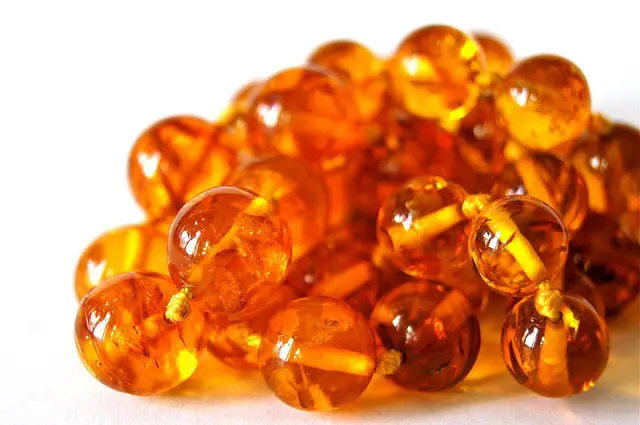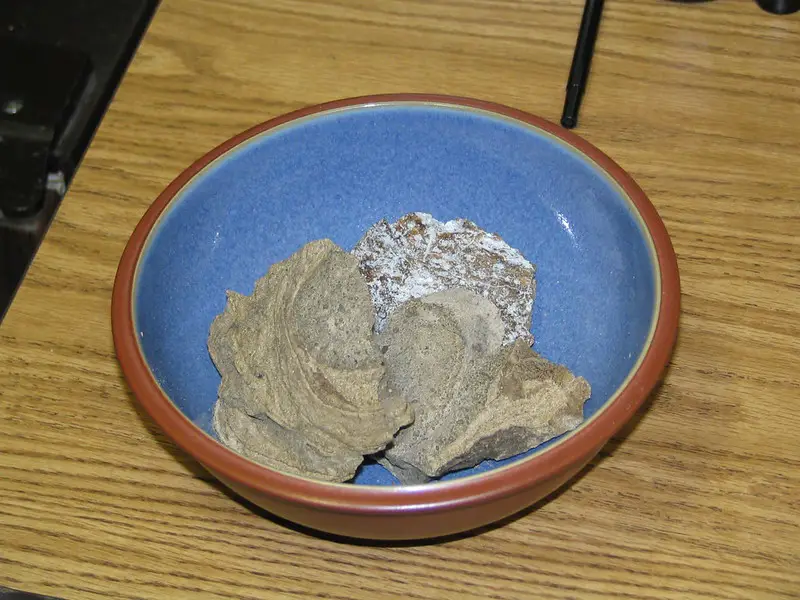Amber is a fossilized tree resin that is prized for its beauty and used in jewelry and other decorative items. Ambergris is a waxy substance produced in the digestive system of sperm whales and has historically been used in perfume-making.
What is amber?
(Image by Uwe Baumann from Pixabay )

Amber is a fossilized tree resin that has hardened over millions of years. It is prized for its unique beauty and is used in jewelry, decorative objects, and other items. Amber can vary in color from pale yellow to deep orange or brown, and may contain inclusions such as insects or plant matter that have been preserved in the resin.
What is ambergris?
(Photo By Peter Kaminski on flickr)

Ambergris is a waxy substance that is produced in the digestive system of sperm whales. It has a unique and complex scent and is highly valued in the fragrance industry for its ability to enhance and fix scents. Historically, it has also been used in medicine and as a flavoring agent in food and beverages.
Amber Vs. Ambergris – Key differences
Amber and ambergris are two distinct substances with several key differences:
Origin: Amber is a fossilized tree resin that has hardened over millions of years, while ambergris is a waxy substance produced in the digestive system of sperm whales.
Appearance: Amber is typically hard and brittle, and ranges in color from pale yellow to deep orange or brown. It may contain inclusions such as insects or plant matter that have been preserved in the resin. Ambergris, on the other hand, is soft and waxy, and is usually gray or black in color.
Value: Amber is highly valued for its unique beauty and is used in jewelry, decorative objects, and other items. Ambergris, meanwhile, is highly valued in the fragrance industry for its ability to enhance and fix scents.
Rarity: While amber is relatively abundant, high-quality ambergris is rare and highly sought after, which contributes to its high value.
Composition: Amber is composed primarily of carbon, hydrogen, and oxygen, while ambergris contains a variety of organic compounds, including ambrein, a chemical compound that gives it its distinctive scent.
Both amber and ambergris are highly prized for their unique properties, they are distinct substances with different origins, appearances, values, and compositions.
What are amber and ambergris used for?
Amber and ambergris are both used for different purposes:
Amber: Amber is primarily used in jewelry and decorative items, such as beads, pendants, and carved figurines. It is also used in the manufacture of other products, such as perfumes and incense.
Ambergris: Ambergris is used primarily in the fragrance industry as a fixative and enhancer for other scents. It has a complex and unique scent that can help to extend the life of other fragrances, and is particularly valued in high-end perfumes. Historically, it has also been used in medicine and as a flavoring agent in food and beverages.
Both amber and ambergris have been used for centuries for their unique properties, and continue to be prized for their beauty, fragrance, and other qualities today.
Alternatives to amber and ambergris
There are a few alternatives to amber and ambergris that can be used in perfumery. These include labdanum, styrax, and benzoin. Each of these materials has a unique scent that can add depth and complexity to a perfume composition.
How do I identify ambergris?
Identifying ambergris can be difficult, as it is a rare and valuable substance that is relatively hard to come by. However, there are a few characteristics that can help you identify it if you do come across it:
Appearance: Ambergris is typically gray or black in color, and has a waxy texture. It may be lumpy or irregular in shape, and can range in size from a few grams to several kilograms.
Scent: Ambergris has a distinctive and complex scent that is difficult to describe. It is often described as musky, earthy, or sweet, with hints of tobacco, wood, or seaweed.
Texture: Ambergris is soft and waxy to the touch, and can become crumbly or brittle with age.
If you think you have come across ambergris, it is important to note that it is illegal to trade or sell in some countries, including the United States, due to its protected status as a product of endangered sperm whales. It is also important to note that there are other substances that can be mistaken for ambergris, so it may be helpful to consult with an expert or professional to confirm its authenticity.
Why is amber perfume expensive?
Amber perfume is expensive for a few reasons. For one, ambergris is much rarer than amber, so there is less of it to go around. Secondly, the process of making ambergris is more labor-intensive than that of making amber. Finally, ambergris has a unique, pleasant scent that many people find irresistible, making it worth the high price tag.
What is the highest quality ambergris?
The highest quality ambergris is known as “black ambergris” or “floating gold.” This type of ambergris is typically very rare and is highly valued by perfumers for its complex and intense scent. Black ambergris is often produced by sperm whales that feed on a particular species of cuttlefish, which gives the ambergris a particularly rich and unique scent. The texture of black ambergris is also typically softer and more pliable than other types of ambergris, which makes it easier to work with in the perfume-making process. Due to its rarity and high demand, black ambergris can be very expensive, with prices ranging from hundreds to thousands of dollars per gram.
How do you know if amber is real?
There are several ways to determine if amber is real or not:
- Look for inclusions: Amber is known for its ability to preserve fossils and other organic matter. If you see small inclusions, such as plant or insect fragments, inside the amber, it is likely real.
- Test the density: Amber is relatively lightweight, and will float in salt water. If you drop a small piece of amber into a glass of salt water and it floats, it is likely real.
- Check for static electricity: Rub the amber against a cloth, and then hold it near a small piece of paper or fabric. If the amber is real, it will create a static charge that will attract the paper or fabric.
- Smell it: Real amber has a distinctive, pleasant scent when heated or rubbed. If the amber has no smell or smells unpleasant, it may be fake.
- Look for bubbles: If the amber has small bubbles or fractures inside, it may be fake. Real amber is typically clear and free of bubbles.
- Seek professional help: If you are unsure about the authenticity of the amber, it may be helpful to consult with an expert or professional, such as a gemologist or jeweler, who can use more advanced testing methods to determine if the amber is real or not.
Featured Image By – Natalia Soto on Unsplash








